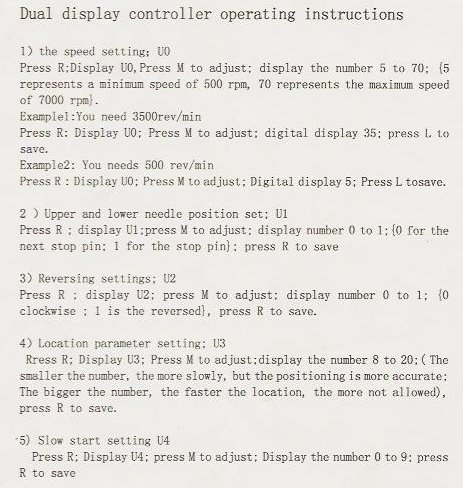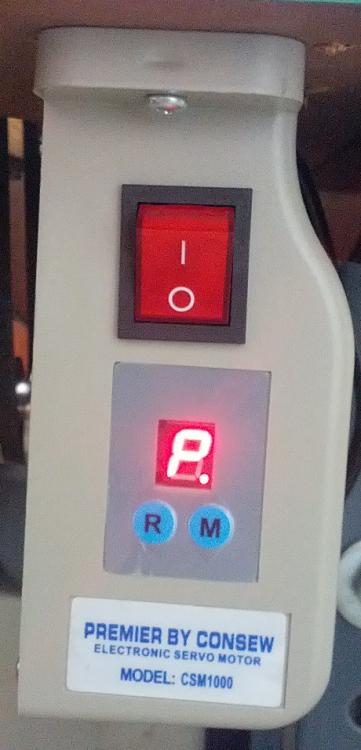-
Content Count
390 -
Joined
-
Last visited
Posts posted by SARK9
-
-
That model seems to be a pretty uncommon mix of machine designs, though it should be a pretty good quality unit. I found this video of a slightly different subclass:
....and while it seems to use the popular Pfaff 335 cylinder arm mechanisms, there are some differences. The machine in the video has some sort of extra hardware behind what is called the "hook cover" on my Mitsubishi CU-865, and the feed plate is much thicker and has an oval shaped through hole which suggests it isn't used for a synchronized binder on this model, at least the way its equipped, while it *does* seem to have the familiar beehive spring at the pivot point. It could *possibly* have an unusual 4 motion underfeed, but its hard to see. You should post some pictures of the business end of the cylinder arm, and maybe a video of the feed dog area in motion. You can see the locations for several of the red oiling holes on the video, if yours is similar.
-DC
-
I've put a scan of the sheet here:
http://leatherworker.net/forum/topic/69254-pfaff-1245-help/?page=2#comment-454459
-
-
There are two versions of the "CSM1000" which are slightly different....and the instructions are not identical. Look at the pictures I posted in the thread linked below and if you need a different one, I can post it for you. One version has a two window display, the other only one. Both have the exact same model number. Sheesh.
http://leatherworker.net/forum/topic/69254-pfaff-1245-help/#comment-453464
-DC
-
The position the handwheel is mounted in DOES make a difference in terms of the direction of rotation....you turn it CCW when its mounted on the end shaft, but *clockwise* if mounted on the side. It won't sew for sure if its turning backwards.
-DC
-
The position of the swivel plate assembly looks a bit odd...it seems to show a large gap above the machine arm, like something may be bent, loose, not assembled correctly, or its getting interfered with from below.
-DC
-
100% opinion here, so that is all its worth.
I have a Consew 206RB5 with servo, which I bought new, and it is really a pretty good machine for what I do with it...the base design is very popular and widely in use, and shares many accessories and repair parts with the legacy machines, making most of the parts extremely affordable in price. I've not had any issues with mine at all, and it performs very well.
That being said, I'll add- The reason I bought the new 206 in the first place was because there was not a Pfaff 1245 in good condition available anywhere within drivable mileage when I had to SOGOTP. If I had been offered a 1245 in known good condition at the time, the choice would have been a no-brainer to me personally. I'd spend a bit more and take some small risks for the Pfaff. Just sayin'.
-DC
-
Just to clarify....Re: The Consew branded "servo" motors....(CSM1000). The more abrupt one is the latest one I bought...it has the "slow start" option 0-9 codes in the typical *all your base" instruction sheet....I can't really tell configuring it has any affect on the sort of sudden pow! this motor has at start.
Although it has the same model number on the control unit, it is obviously different than the earlier CSM1000 I have, which is quite well mannered. This is the abrupt one:
....and this is the slightly older one that starts perfectly smoothly:
Both are sold as CSM1000's.....
-DC
-
I've used a a few similar "servo" motors (branded by Consew), but all without the needle positioners....many of these imported offerings share so many similarities one might assume they are all made under the same roof. I am currently using 6 machines with these motors installed and have sold/traded off 4 other machines using older versions of the same motors. I personally haven't had one DOA or any other issues with the 10 or so I've bought....though the oldest one I have has only been in use for about 3 years. I do use a speed reducer on the 3 walking foot machines that are similar to the 1245, but run them direct on higher speed fabric machines like my Pfaff 483.
A couple of dings I would give the ones I use: They come standard with either a 90mm or 75mm pulley, which I usually replace with a 50mm. The more recent ones I've purchased now seem to start rather abruptly....still fine at about one stitch per second or less, but really POW! when they come on.
-DC
-
Constab: >> [...] I don´t see a stitch length adjuster mechanism. When you open the lid on the top right do you see a dial with numbers?<<
I've not actually owned a "real" Singer 111, but I don't see anything like what I'd recognize as a *feed eccentric* assembly anywhere on the underside view, either, unless it totally miniaturized.
-DC
-
It could be a simple visual anomaly from all the blood rushing into my left ear, but the cream model *looks* like it may have the larger *M* style bobbin, which would be an advantage over what seems to be a *G* style (or its Pfaff equivalent) in the very nice grey machine. Check out the subclass specs to confirm, but its a definite plus if its true.
Update: All I see listed for the 1245's are M-style.... check the subclass to be sure.
-DC
-
This is my Pfaff 481....high speed needle feed, straight stitch only.
Yours seems to have the little "paddle" missing from the manual presser foot lift. I think I can see the knee lift in the photo....
There are umpteen similar Pfaff models that are almost visually identical....463-481-483. I think the 461 and 563 don't have the built in bobbin winder, but I've not seen very many.
-DC
-
I recently bought a Consew 29B and it had some similar (though minor) hiccups....but on the whole, its overall build quality really isn't that bad. The Consew seemed to be a bit too fussy about its bobbins and tensions at first, and I finally replaced the original shuttle with a good quality Japanese aftermarket unit and it made a world of difference....all tension problems evaporated. Mine is a large bobbin machine however, so it may be apples and oranges here.
The main flaw mine had which occasionally caused the odd skipped stitch was; The machined area on the needle bar which accepts the *thread tension spring* was either milled a tad too short, or the furnished spring is a few thou too long...so the working tip would occasionally bind in its recess and not apply any tension at all to the thread. I very slightly re-arched it and it is able to move freely now. Any issues with that little flat spring seem to bring skipped stitches.
-DC
-
For anyone that actually *likes* using a droning clutch motor for stitch-at-a-time accuracy while doing artistic work on expensive materials, this certainly is a golden age, as one can happily harvest their fill from the rest of the Earth's refuse pits, and welcome. However, I don't think a random example of this temperamental tribe is something I would wish on an enthusiastic newcomer. Its really only an outdated piece of single-purpose factory cast-off, unless there are some really keen rites and incantations involved with their possession that I was never invited to see. I do know how to release the magic smoke on any of them: It stinks as well, but the infernal din finally stops.
-DC
-
As someone new to these machines, I would be surprised if you found your initiation into the archaic world of buzzing clutch motors something very enjoyable. Unless you really need to jump right into the super hard and thick materials right off the bat, and need a further challenge as you learn to precisely control your stitching, I too suggest getting the best servo you can afford *first*. Try to find a suitable model that comes with a pulley around 50mm.
There are also a pretty good number of DIY speed reducer designs that people have been kind enough to share here, so a quick search and a bit of reading may spark a cost saving idea or two that will serve well in the meanwhile.
Otherwise, you may find, as countless others have lamented, there are some very sound reasons that the boneyard pallets are piled high with discarded clutch motors across the width and breadth of this land.
-DC
-
The newer generation of brushless, all-electronic servomotors are now configured in a *modular* assembly, in such a way that you can mount the various components remote from their traditional locations in just about any way you need. I was out of table space in my area when I added a patcher-type machine, but I was able to use an existing work counter and easily locate the servo components in the most convenient way. Its simply too easy.
Dead easy to locate the actuator anywhere you need to align it.
-DC
-
All three candidates are nice machines. The main thing the Pfaff has to recommend it is its price...I'm not sure its in the same class as the others in terms of stitch length, thread size and capacity, plus its an "automatic oiler"-- which suggests it is designed more for high speed operation. I also have a Pfaff 481 which is in the same "family" of machines as the one you show...mine uses a needle-feed and bottom feed transport, and I'd guess the main difference is yours also has a rather complex walking presser foot added in. Its a nice machine for FABRIC, which is what I use mine for.
I own and use a Juki LU-563, and the one you are considering looks to be lightly used and in nice shape. These are based on a well understood series of machine designs and models that are quite popular, can handle slightly heavier work than what you mentioned, and have the advantage of readily available/inexpensive parts, accessories and information. The quality is very good as these were made in Japan and well executed. It DOES have a clutch motor, which may or may not be a show stopper...some of them are less heart-stopping than others, and you may find you possess the Olympics-grade physical and mental gifts that allow you to be comfortable with FEATHERING these stark, noisy power hogs. If not, you will need to budget in an inexpensive "servo motor" or try out smaller motor pulleys combined with speed reducers. Without some hint as to which part of the Europlanet you are shopping in, this could be a rather expensive plan.
No question that the Adler is a great machine for your requirements, but it may be surprisingly expensive to maintain in terms of repair parts or add-on accessories (IF EVER NEEDED) in comparison to the Juki. The motor looks like a programmable commercial/factory power solution with optional outputs for things like foot lifts, reverse stitching, and maybe on-the-fly patterns and stitch lengths. You will need to check the required voltages in your area to see if its compatible in a non-factory setting, and check into whether it requires compressed air and some minor plumbing to take advantage of its various features. Some of those motors are pretty configurable and not beyond understanding. I got a Mitsubishi LimiStop Z on one of mine (which I don't actually use) but it had pretty readily available manuals and literature and sounded pretty interesting, though it was not at all what I needed. I replaced it with an inexpensive servo motor, and if you find you need to as well, then you may weight the advantage to the Juki of these 3 candidates.
Toss a coin to decide between the Juki and Adler, then go best of 3, and then best 3-out-of-5 until you get the one you actually want subconsciously. Good luck-
-DC
-
Your thread choice depends on how strong it has to be and/or how the appearance fits your application. I tend to think the B69/T70 thread is a tad too small for most of the stuff I would do with that material, but that is specific to its use. One thing though: If you are going to use your marine vinyl in an actual marine environment, or even in an outdoor setting where the stitching is fully exposed, then nylon isn't the best choice for UV resistance. Polyester threads (Dabond, SunGuard etc.) are better for outdoor use, with the even more inert and MUCH pricier options (like Tenara) or other PTFE threads used in especially severe settings.
-DC
-
On the Juki LU-563, there are similar parts to the ones numbered 14 (pan) and 15 (felt pad), which are nailed in place in the drip tray directly under the lower bushing of the hook assembly. It is in contact with the oil saturated felt, and inside this bearing housing, the shaft has a section of machined spiral grooves which create a slow flow of oil to the hook area. I have no idea if that is exactly how the 1508 is designed, but the parts have similarities.
-DC
-
-
Nice find!
-DC
-
Thanks Glenn-
I ordered a 10 pack and will verify.... I'll update if there are any issues. The Consew 29B is made in Taiwan and they are *supposed* to be a pretty close clone-off, but...
-DC
-
Thanks Constabulary-
I have some here for a Consew 29B that measure 20.03 X 7.6 X 5.8. I'm checking for interoperability of spare parts with the originals.
Appreciate it!
-DC
-
Does anyone have a large original bobbin for a big hook Singer 29K they can throw a set of calipers on? I need the diameter, height, and hole size for a comparison.
Thanks!
-DC











Searching for Nakajima 381L info
in Leather Sewing Machines
Posted · Report reply
I don't find anything closer than the Juki DSC either, and it really does look similar. I'd go with whatever the Juki DSC 245 uses for starters. Looks like a horizontal lower feed is all that is offered on the Juki, so it probably does share that as well.
You can get the engineer's manual for that machine here:
http://dixiesewingmachine.tzo.com/JUKI%20SERVICE.htm
...and compare it with the Nakajima. Looks pretty close, as you say.
-DC